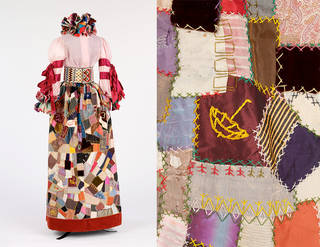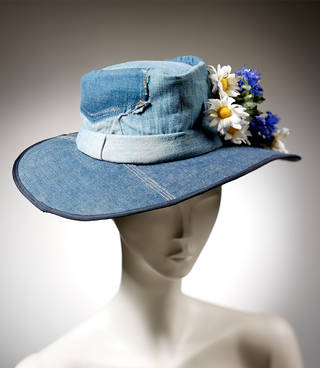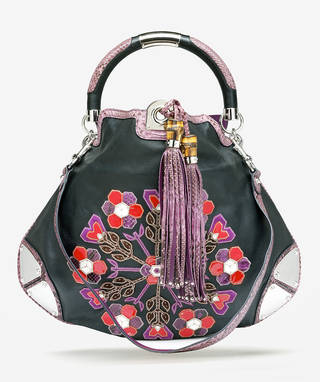Once a means of using up left-over fabric scraps, in the 1960s patchwork was adopted by mainstream and high-fashion designers, thanks to the influence of hippie culture. Today the technique remains a perennial fashion favourite.
Patchwork's first use in clothing was as a technique of economy – a way of using up scraps of fabrics or of extending the working life of a garment. During the Second World War, the journalist Anne Scott-James wrote a feature for Picture Post, championing patchwork as a technique which wouldn't use up one's ration of clothing coupons. "Cottons and ginghams are by far the best," she advised, "in pale demure colours, with an occasional patch of Victorian purple or red". That's not to say that the fabrics used for patchwork weren't in themselves luxurious – our collection includes clothing created in the 1950s with off-cuts from the London couture salons of both Digby Morton and Norman Hartnell.
Meanwhile other designers recognised patchwork's potential as a decorative technique in its own right. Natalia Goncharova had a long career designing costumes for Sergei Diaghilev's Ballets Russes. Like many other Russian refugees in Paris, she also designed fashion dresses – our collection includes a silk dress dating to 1923, when Goncharova was employed by Maison Myrbor, an exclusive shop owned by the Italian Marie Cuttoli. Cuttoli worked with contemporary artists such as Picasso and Matisse – and sold fashion, rugs and curtains designs by the international avant-garde to a wealthy audience.

Goncharova's red silk dress is embellished with appliquéd multi-coloured silks and velvets in a patchwork style effect, perhaps echoing the Cubist art being explored during the period. When the dress was donated to the Museum, it was thought that the patchwork was produced in workshops in Algeria for Madame Cuttoli.
It was, however, not until the late 1960s when patchwork really began to be associated with fashion. This period saw the rise of traditional handicrafts as an alternative to mainstream fashions. As a technique, patchwork was inexpensive, easy to do yourself and a great way of adding individuality to an outfit, whether adding patches to a pair of jeans or creating something more elaborate.
In this way patchwork became more than a technique – it became a 'look', as in Pauline Allen's 1969 evening dress, which uses colourful and contrasting colours and patterns to give a mismatched effect, a reaction to the streamlined, Space Age fashions popular in the period.
Another factor in patchwork's popularity was the rise of the Hippie Trail. During the 1960s and 70s, thousands made a journey overland from Europe through to South Asia, drawn by the promise of self-discovery, adventure and of experiencing places and cultures far removed from Western capitalism. Its influence filtered down into fashion, such as the introduction of kaftans, which were traditionally worn in places including Turkey and Morocco. Thea Porter took her inspiration from an exotic view of the Middle East, where she had lived until the early 1960s. Her designs incorporated antique fabrics and richly patterned silks, translating Middle Eastern fashions for an affluent hippie audience. Each of her collections featured a reworking of the kaftan – a 1968 example can be seen decorated with satin and chiffon patchwork as well as incorporating metallic thread and mirror glass.

In the late 1960s there was also a growing appreciation for the skills and work required to produce patchwork. An opulent 1967 design by Adolfo, who opened his New York salon five years earlier, repurposes an antique 'crazy quilt'. Popular in the late 19th century, 'crazy' patchwork designs are made of seemingly randomly placed irregular-sized pieces. In his design, Adolfo treats the repurposed quilt with respect, gathering, rather than cutting it for the skirt. His designs embrace a mix and match philosophy. As he remarked, "Today, one has to dress in bits and pieces – the more the merrier".

Manufacturers catering to a youth market were quick to pick up on the patchwork trend. A 1970s hat by Mr Denim, made of recycled denim – at that time, a material very much still only associated with jeans – shows shifting attitudes towards both patchwork and the wearing of hats. High fashion designers attuned to street-style also adopted patchwork as a look. Yves Saint Laurent, for example, designed patchwork dresses, while our collection includes an example of a patchwork-patterned silk blouse by Dior.

The patchwork trend continued into the early 1970s, when it was used across an expanded range of materials. Designers such as Roberto Cavalli, Stephen Burrows and Giorgio di Sant'Angelo were known for designs using patchwork of leather, suede and – in the case of a pair of Terry de Havilland shoes – snakeskin.

Although it never completely went away, patchwork resurfaced as a major fashion trend in the early 1990s, as part of the backlash against the slick corporate styles of the previous decade. Designers looked to create a handmade, homespun feel, as seen in the 'grunge' look promoted by Marc Jacobs at Perry Ellis. As street-style embraced a revival of hippie-style, high fashion designers watched closely. By the decade's end, handmade elements were seen in the likes of Tom Ford's collections for Gucci, where flared denim jeans featured braided trims and feathers.
In the 21st century patchwork continues to be referenced, particularly when designers want to create a romantic, hand-crafted feel, such as in a 2007 bag by Gucci. Patchwork remains a perennial favourite, regularly appearing in different designers' collections – now far removed from its origins as an economical technique.


